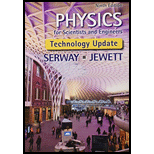
(a)
The current in the circuit and phase relative to the applied voltage.
(a)
Answer to Problem 33.60AP
The current in the circuit is
Explanation of Solution
Given info: The resistance of the circuit is
Write the expression to calculate the inductive resistance of the circuit.
Here,
Substitute
Thus, the inductive resistance of the system is
Write the expression to calculate the capacitive resistance of the circuit.
Here,
Substitute
Thus, the capacitive resistance of the system is
Write the expression to calculate the impedance of the circuit.
Here,
Substitute
Thus, the impedance of the circuit is
Write the expression to calculate the current in the circuit.
Here,
Substitute
Thus, the current in the circuit is
Write the expression to calculate the phase angle.
Here,
Substitute
Thus, the phase angle is
Conclusion:
Therefore, the current in the circuit is
(b)
The maximum voltage across resistor and its phase relative to the current.
(b)
Answer to Problem 33.60AP
The maximum voltage across resistor is
Explanation of Solution
Given info: The resistance of the circuit is
Write the expression to calculate the voltage across resistor.
Here,
Substitute
Thus, the voltage across resistor is
In case of resistance, the phase difference between the voltage and current across resistor is zero. Hence, the phase relative to current is
Conclusion:
Therefore, the maximum voltage across resistor is
(c)
The maximum voltage across capacitor and its phase relative to the current.
(c)
Answer to Problem 33.60AP
The maximum voltage across capacitor is
Explanation of Solution
Given info: The resistance of the circuit is
Write the expression to calculate the voltage across capacitor.
Here,
Substitute
Thus, the voltage across capacitor is
In case of capacitor the current leads in the capacitor lags the voltage by
Conclusion:
Therefore, the maximum voltage across capacitor is
(d)
The maximum voltage across inductor and its phase relative to the current.
(d)
Answer to Problem 33.60AP
The maximum voltage across inductor is
Explanation of Solution
Given info: The resistance of the circuit is
Write the expression to calculate the voltage across inductor.
Here,
Substitute
Thus, the voltage across inductor is
In case of capacitor the current leads in the inductor leads the voltage by
Conclusion:
Therefore, the maximum voltage across inductor is
Want to see more full solutions like this?
Chapter 33 Solutions
Bundle: Physics for Scientists and Engineers, Technology Update, 9th Loose-leaf Version + WebAssign Printed Access Card, Multi-Term
- Students are asked to use circular motion to measure the coefficient of static friction between two materials. They have a round turntable with a surface made from one of the materials, for which they can vary the speed of rotation. They also have a small block of mass m made from the sec- ond material. A rough sketch of the apparatus is shown in the figure below. Additionally they have equipment normally found in a physics classroom. Axis m (a) Briefly describe a procedure that would allow you to use this apparatus to calculate the coefficient of static friction, u. (b) Based on your procedure, determine how to analyze the data collected to calculate the coefficient of friction. (c) One group of students collects the following data. r (m) fm (rev/s) 0.050 1.30 0.10 0.88 0.15 0.74 0.20 0.61 0.25 0.58 i. Use the empty spaces in the table as needed to calculate quantities that would allow you to use the slope of a line graph to calculate the coefficient of friction, providing labels with…arrow_forwardPART Aarrow_forwardanswer both questionarrow_forward
- Only part A.) of the questionarrow_forwardIn general it is best to conceptualize vectors as arrows in space, and then to make calculations with them using their components. (You must first specify a coordinate system in order to find the components of each arrow.) This problem gives you some practice with the components. Let vectors A = (1,0, -3), B = (-2, 5, 1), and C = (3,1,1). Calculate the following, and express your answers as ordered triplets of values separated by commas.arrow_forwardIn general it is best to conceptualize vectors as arrows in space, and then to make calculations with them using their components. (You must first specify a coordinate system in order to find the components of each arrow.) This problem gives you some practice with the components. Let vectors A = (1,0, −3), B = (-2, 5, 1), and C = (3,1,1). Calculate the following, and express your answers as ordered triplets of values separated by commas.arrow_forward
- In general it is best to conceptualize vectors as arrows in space, and then to make calculations with them using their components. (You must first specify a coordinate system in order to find the components of each arrow.) This problem gives you some practice with the components. Let vectors A = (1,0, -3), B = (-2, 5, 1), and C = (3,1,1). Calculate the following, and express your answers as ordered triplets of values separated by commas.arrow_forwardfine the magnitude of the vector product express in sq meters what direction is the vector product in -z or +zarrow_forward4) Three point charges of magnitude Q1 = +2.0 μC, Q2 = +3.0 μС, Q3 = = +4.0 μС are located at the corners of a triangle as shown in the figure below. Assume d = 20 cm. (a) Find the resultant force vector acting on Q3. (b) Find the magnitude and direction of the force. d Q3 60° d Q1 60° 60° Q2 darrow_forward
 Physics for Scientists and Engineers, Technology ...PhysicsISBN:9781305116399Author:Raymond A. Serway, John W. JewettPublisher:Cengage Learning
Physics for Scientists and Engineers, Technology ...PhysicsISBN:9781305116399Author:Raymond A. Serway, John W. JewettPublisher:Cengage Learning
 College PhysicsPhysicsISBN:9781305952300Author:Raymond A. Serway, Chris VuillePublisher:Cengage Learning
College PhysicsPhysicsISBN:9781305952300Author:Raymond A. Serway, Chris VuillePublisher:Cengage Learning College PhysicsPhysicsISBN:9781285737027Author:Raymond A. Serway, Chris VuillePublisher:Cengage Learning
College PhysicsPhysicsISBN:9781285737027Author:Raymond A. Serway, Chris VuillePublisher:Cengage Learning Glencoe Physics: Principles and Problems, Student...PhysicsISBN:9780078807213Author:Paul W. ZitzewitzPublisher:Glencoe/McGraw-Hill
Glencoe Physics: Principles and Problems, Student...PhysicsISBN:9780078807213Author:Paul W. ZitzewitzPublisher:Glencoe/McGraw-Hill College PhysicsPhysicsISBN:9781938168000Author:Paul Peter Urone, Roger HinrichsPublisher:OpenStax College
College PhysicsPhysicsISBN:9781938168000Author:Paul Peter Urone, Roger HinrichsPublisher:OpenStax College





